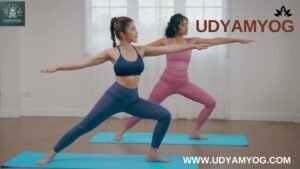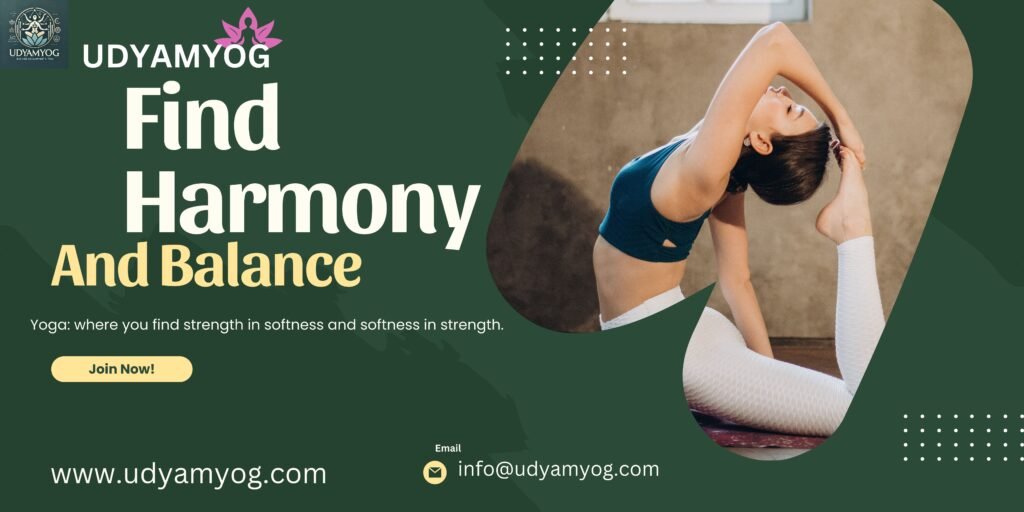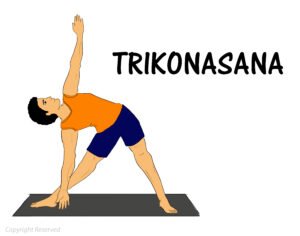Trikonasana (Triangle Pose): Strengthen Your Body and Mind
At udyamyog.com, we emphasize the importance of proper technique in yoga. Trikonasana, also known as Triangle Pose, is a fundamental standing pose that can have a profound impact on your posture, strength, and flexibility. By incorporating Trikonasana into your yoga routine, you can strengthen your core and legs while improving your overall balance. In this article, we will guide you on the correct execution of Trikonasana, highlight its numerous benefits, provide tips for avoiding common mistakes, and offer modifications to accommodate practitioners of different levels.
What is Trikonasana (Triangle Pose)?
Trikonasana (Triangle Pose): Strengthen Your Body and Mind
Trikonasana,comes from the Sanskrit words “Trikona,” meaning triangle, and “Asana,” meaning pose. This standing posture creates a triangular shape with the body, requiring you to stretch and reach, building strength, and flexibility along the way.
Unlike other poses, Trikonasana is dynamic yet still, stretching several parts of the body while also enhancing balance and grounding. It’s not just a physical challenge—it’s an opportunity to focus on the present moment, making it a great way to cultivate mindfulness.
Why You Should Practice Trikonasana Practicing Trikonasana offers numerous benefits for both the mind and body. This foundational yoga pose helps improve flexibility, strengthen the legs and core, and enhance balance. Additionally, Trikonasana promotes a sense of stability and focus, making it an excellent addition to any yoga routine.
While some yoga poses focus primarily on flexibility or strength, Trikonasana Offers a holistic approach. It not only targets the muscles in your body but also improves mental focus and awareness. This is why it is considered one of the foundational postures in most yoga classes.
Let’s dive deeper into how you can perform the pose properly and what makes it such a beneficial addition to your yoga routine.
Trikonasana (Triangle Pose): Strengthen Your Body and Mind

How to Perform Trikonasana (Triangle Pose)
Here’s a step-by-step guide to practicing Trikonasana the right way:
Step-by-Step Instructions:
Keep your legs straight without locking your knees. Lift your kneecaps and engage your quadriceps to protect the knee joints. Hold the pose for 5-10 breaths, feeling the stretch along the side body, the strengthening of the legs, and the grounding of your feet. To come out of the pose, inhale and lift back to a standing position with your arms extended to the sides. Turn your feet to face forward and repeat the steps on the left side. Trikonasana (Triangle Pose) offers a full-body workout and numerous benefits, making it a valuable addition to your regular yoga practice.
- Improves Posture
In today’s world of constant sitting and poor posture, Trikonasana is a powerful way to align your spine and improve your posture. By opening the chest and stretching the sides of the torso, this pose helps counteract the rounding of shoulders and slouching that comes with long hours of sitting. It promotes lengthening of the spine and encourages a strong, upright posture.
Strengthens Legs and Core
Trikonasana may look like a simple stretch, but it requires strong engagement of the legs and core. As you reach down with one hand and lift the other toward the ceiling, your legs and core must work hard to maintain balance. Over time, this strengthens the thighs, knees, calves, and ankles, building a solid foundation of lower body strength. Additionally, the core muscles are engaged to keep your torso stable and upright, which also helps improve balance.
Increases Flexibility
One of the most obvious benefits of Trikonasana is its ability to increase flexibility, especially in the hips, hamstrings, and groin. This deep stretch targets multiple areas at once, making it an efficient way to open up tight muscles. Practicing this pose regularly can significantly improve your flexibility, which helps in everyday movements and in more advanced yoga poses.
Stretches the Side Body
Many yoga poses focus on forward or backward bending, but Trikonasana is unique because it involves a deep lateral stretch. This lengthens the sides of the body, creating space in the torso, and stretching the intercostal muscles (the muscles between the ribs). This can improve lung capacity and deepen your breathing.
Boosts Mental Focus and Stability:
Balancing in Trikonasana requires concentration and mindfulness. As you align your body and focus on your breath, this pose encourages mental clarity and focus. It also teaches you to remain stable and grounded, even in challenging positions, which can be a powerful metaphor for life’s challenges.
Reduces Stress and Anxiety.
Like many yoga poses, Trikonasana has a calming effect on the mind. By focusing on your breath and staying present in the pose, it can help alleviate stress and anxiety. The deep stretch in the body also helps release tension, leaving you feeling more relaxed and centered.

Common Mistakes in Trikonasana
While Trikonasana is a foundational pose, it is easy to make a few common mistakes. Be mindful of the following to ensure you are practicing the pose correctly:
Leaning Forward: Avoid leaning too far forward with your upper body. Instead, focus on keeping your torso in line with your legs, as if you’re sandwiched between two panes of glass.
Locking the Knees: Keep your knees straight, but avoid locking them. Engage your thigh muscles to protect the knee joints.
Collapsing the Chest: Don’t allow your chest to collapse forward. Keep your chest open and your shoulders stacked, one on top of the other.
Overreaching: It’s tempting to reach down to the floor, but prioritize alignment over depth. If you need to place your hand on your shin or use a yoga block, do so to maintain proper alignment.
Modifications and Variations of Trikonasana
Trikonasana can be modified to suit your level of flexibility and strength:
Use a Block: If you can’t reach the floor comfortably, place a yoga block under your bottom hand. This will help you maintain alignment without straining.
Bent Knee Variation: If you have tight hamstrings, keep a slight bend in your front knee to avoid injury.
Bind Variation: For a deeper challenge, advanced practitioners can try the
Bound Triangle Pose, where you clasp your hands behind your back while in the pose.

Conclusion
Trikonasana (Triangle Pose) is a powerful and versatile yoga posture that benefits both the body and mind. Whether you’re looking to improve your posture, strengthen your legs, or find a moment of mental clarity, Trikonasana is the perfect pose to incorporate into your daily yoga routine.
At, udyamyog.com, we encourage you to practice this pose regularly and notice the positive changes it can bring. As with any yoga practice, the key is consistency and mindfulness. Whether you are a beginner or an experienced yogi, Trikonasana offers something for everyone. So, step onto your mat, take a deep breath, and embrace the strength and balance that Triangle Pose can bring to your life.
Trikonasana (Triangle Pose): Strengthen Your Body and Mind



1 thought on “Trikonasana (Triangle Pose): Strengthen Your Body and Mind”